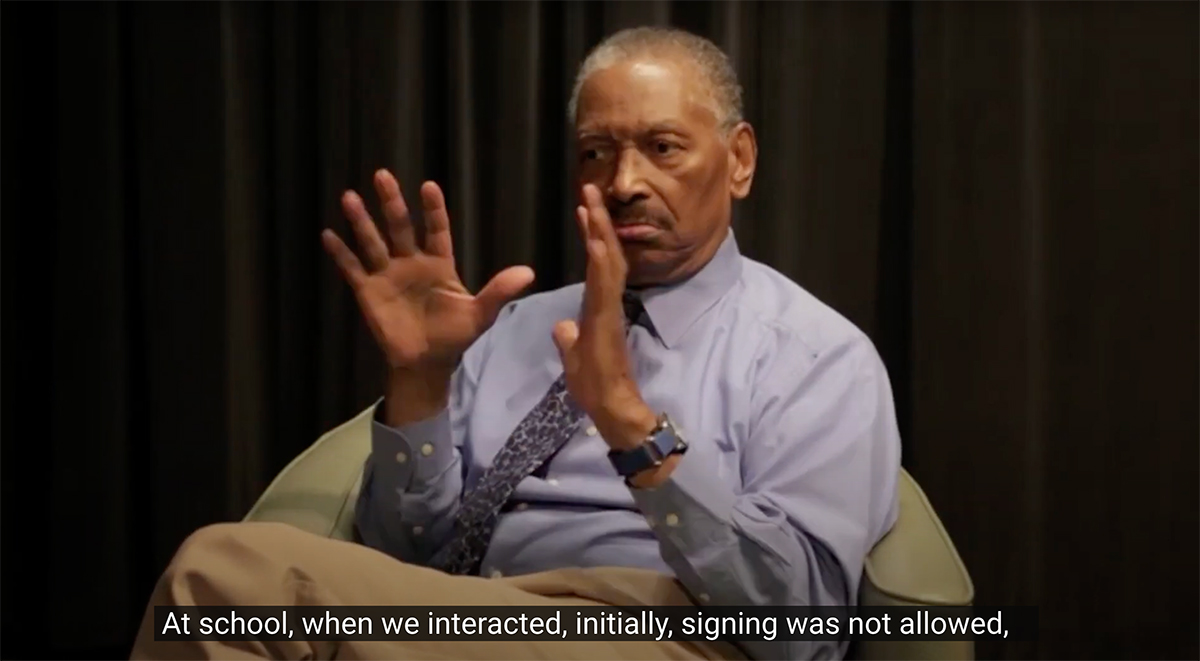You are here:
Interview with Thomas Samuels

Date: Oct 14, 2020
Caption: Thomas Samuels recalls his experiences as a teenager meeting with fellow Deaf teens on 14th Street in Manhattan.
Transcript: At school, when we interacted, initially, signing was not allowed, that we’d be punished if we used signing. We only signed when we knew the teachers weren’t looking. We hid our signs. But when we were outside of school, we used sign freely. When groups of us went on trips, we signed. So, for me, I didn’t sleep at the school. I commuted back and forth between home and school on the train and it was a lot of fun. When class was over, at 2:30, we couldn’t wait to get together and get on the train. You know, in New York City, we had an area where we would all meet that was well known, under the 14th Street train. We’d gather and converse and just have a great time. I enjoyed that so much. We didn’t have student clubs or groups, so that time at 14th Street was what we did. We met as a group and had a good time together. Also, we did have sports teams. They were run by Deaf clubs. So, interacting and spending time in that setting exposed me to many great things.
Thomas Samuels grew up and went to high school in New York City. He is Deaf, and as he mentions in his interview, he and fellow Deaf teenagers would meet up near the 14th Street subway station on Friday afternoons after school. At some schools at the time, students were prohibited from signing or using sign language to communicate with each other. They were expected to learn to speak and to understand others by lip-reading English instead, and were punished if they used sign language. Students like Samuels and his friends preferred to sign with one another, as did many Deaf people. They used signing to communicate with each other when they met up for fun on 14th Street. One of Samuels’ friends who was present remembers that the police would come and try to break up the gathering of teenagers, but the group would come back together and keep exchanging news and connecting with their friends.
Deaf teenagers found it convenient to meet close by a subway station. Deaf people lived all over New York City, and students traveled to come to school. A subway station made a convenient meeting point, and students could travel home to their neighborhoods from there. However, recognizing that the subway has many inaccessible stations even today, Deaf students with mobility impairments would not have found the school, or this meeting point, to be accessible.
Many Black Deaf people in New York City spoke Black ASL, in dialects that originated in New York or in parts of the South. Samuels doesn’t mention whether he spoke ASL or Black ASL with his friends.
Categories: student activism, K-12 organizing, Manhattan
Tags: Deaf culture, Disabled people, joy, American Sign Language, curriculum, self-advocacy, autonomous educational spaces, Black people, transportation
This item is part of "Deaf Social Spaces" in "Joyful Struggle"
Item Details
Date: Oct 14, 2020
Creator: Thomas Samuels and Brianna DiGiovanni
Source: Deaf Social Spaces in NYC, Deaf Documentary Center at Gallaudet University
Copyright: Under copyright. Used with permission.
How to cite: “Interview with Thomas Samuels,” Thomas Samuels and Brianna DiGiovanni, in New York City Civil Rights History Project, Accessed: [Month Day, Year], https://nyccivilrightshistory.org/gallery/thomas-samuels-interview.
Questions to Consider
- In your own life, where do you feel safe to gather with your friends and communicate as you choose? What meaning does that space hold for you?
- Who should decide how young people communicate at school—students, teachers, parents, or someone else?
- How do you see joy in this interview? How do you see politics or struggle?
- Does Samuels’ story remind you of places in your own life? If so, why? (Try to explain using a “because” statement, like “This reminds me of _______ because ________.”)
References
How to Print this Page
- Press Ctrl + P or Cmd + P to open the print dialogue window.
- Under settings, choose "display headers and footers" if you want to print page numbers and the web address.
- Embedded PDF files will not print as part of the page. For best printing results, download the PDF and print from Adobe Reader or Preview.
